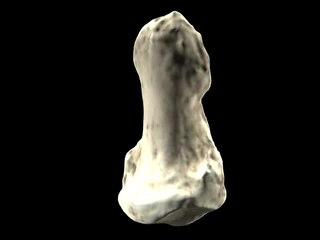
Orrorin is an extinct genus of primate within Homininae from the Miocene Lukeino Formation and Pliocene Mabaget Formation, both of Kenya.

Sagittariidae is a family of raptor with one living species—the secretarybird native to Africa—and a few fossil taxa.
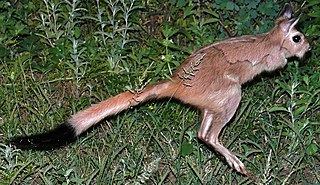
The South African springhare is a medium-sized terrestrial and burrowing rodent. Despite the name, it is not a hare. It is one of two extant species in the genus Pedetes, and is native to southern Africa. Formerly, the genus was considered monotypic and the East African springhare was included in P. capensis.

Ostriches are large flightless birds. Two living species are recognised, the common ostrich, native to large areas of sub-Saharan Africa, and the Somali ostrich, native to the Horn of Africa.
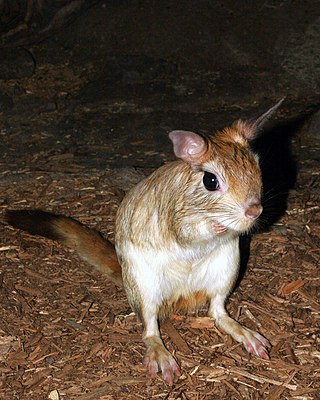
The Pedetidae are a family of rodents. The two living species, the springhares, are distributed throughout much of southern Africa and also around Kenya, Tanzania, and Uganda. Fossils have been found as far north as Turkey. Together with the anomalures and zenkerella, Pedetidae forms the suborder Anomaluromorpha. The fossil genus Parapedetes is also related.

Pedetes is a genus of rodent, the springhares, in the family Pedetidae. Members of the genus are distributed across southern and Eastern Africa.

Anomaluromorpha is a clade that unites the anomalures, springhares, and zenkerella. It has alternately been designated as either a suborder or infraorder. Most recently, Carleton & Musser 2005 recognized it as one of five suborders of rodents.

Diatomyidae is a family of hystricomorph rodents. It is represented by a single living species, Laonastes aenigmamus, native to Laos in Southeast Asia. Fossil species are known from the Oligocene and Miocene of Asia and eastern Europe.

Diatomys is an extinct rodent genus known from Miocene deposits in China, Japan, Pakistan, and Thailand. The fossil range is from the late Early Miocene to the Middle Miocene.

Galulatherium is an extinct genus of possibly gondwanathere mammal, from the Late Cretaceous (Turonian-Campanian)-aged Galula Formation of Tanzania. It is known solely from the type specimen TNM 02067 a fragmentary fossil dentary. The short, deep bone is about 19.5 mm (0.77 in) long, but the back part is broken off. It contains a large, forward-inclined incisor with a root that extends deep into the jaw, separated by a diastema (gap) from five cheekteeth. Very little remains of the teeth, but enough to determine that they are hypsodont (high-crowned). The third cheektooth is the largest and the roots of the teeth are curved. First described in 2003, TNM 02067 has been tentatively identified as a sudamericid—an extinct family of high-crowned gondwanathere mammals otherwise known from South America, Madagascar, India, and Antarctica. If truly a gondwanathere, it would be the only African member of the group and may be the oldest. The describers could not exclude other possibilities, such as that the jaw represents some mammalian group known only from younger, Cenozoic times. In 2019 the fossil was CT scanned, which revealed additional details of the specimen.
Rimasuchus is an extinct genus of crocodile from the Miocene of Egypt and possibly Libya. Only one species - Rimasuchus lloydi - is currently known. It was previously thought to be a species of Crocodylus, but is now thought to be more closely related to the modern African dwarf crocodiles (Osteolaemus).

The East African springhare is an African mammal that is not closely related to the hare, which is not a lagomorph, but is a member of the Pedetidae, a rodent family.
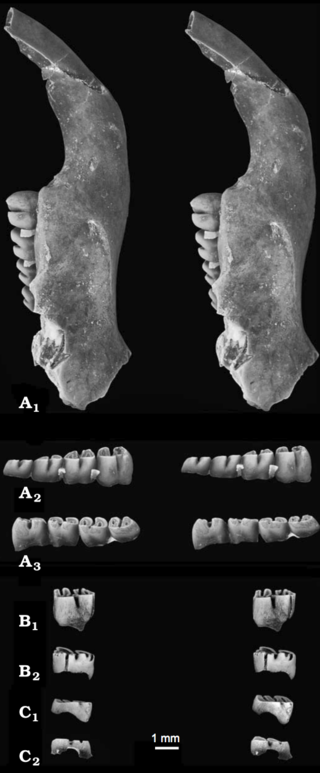
Apeomyoides savagei is a fossil rodent from the Miocene of the United States, the only species in the genus Apeomyoides. It is known from fragmentary jaws and isolated teeth from a site in the early Barstovian, around 15–16 million years ago, of Nevada. Together with other species from scattered localities in the United States, Japan, and Europe, Apeomyoides is classified in the subfamily Apeomyinae of the extinct rodent family Eomyidae. Apeomyines are a rare but widespread group that may have been adapted to a relatively dry habitat.
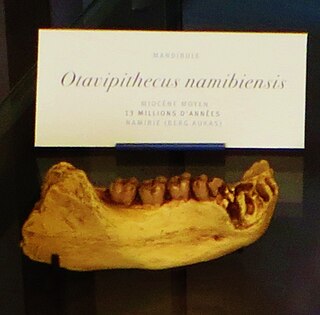
Otavipithecus namibiensis is an extinct species of ape from the Miocene of Namibia. The fossils were discovered at the Berg Aukas mines in the foothills of the Otavi mountains, hence the generic name. The species was described in 1992 by Glenn Conroy and colleagues, and was at the time the only non-hominin fossil ape known from Southern Africa. The scientists noted that the surrounding area of the discovered specimen included fauna dated at "about 13 ± 1 Myr". The fossils consist of part of the lower jawbone with molars, a partial frontal bone, a heavily damaged ulna, one vertebra and a partial finger bone.
"Crocodylus" gariepensis is an extinct species of crocodile that lived in southern Africa during the Early Miocene about 17.5 million years ago (Ma). Fossils have been found along a bank of the Orange River in Namibia, near its border with South Africa.
The Hiwegi Formation is a geological formation on Rusinga Island in Kenya preserving fossils dating to the Early Miocene period. The Hiwegi Formation is known for the well preserved plant fossils it preserves, which indicate a tropical forest environment that underwent wet and dry periods. The middle members of the formation in particular indicate a brief period in which conditions were notably dryer with a more open environment compared to older and younger units. Some of the formation's fauna, such as an early ancestor of the modern aye-aye and a chameleon of the genus Calumma, link Miocene East Africa to modern day Madagascar.
Diamantofelis is an extinct genus of felids that lived in what is now Namibia during the Early Miocene. It contains a single species, Diamantofelis ferox.
Namafelis is an extinct genus of felids that lived in what is now Namibia during the Early Miocene. It contains a single species, Namafelis minor. Closely related to Diamantofelis, it is of “Pseudaelurus-grade”, and therefore a rather basal member of the cat family.
Namibiocyon is an extinct genus of carnivoran mammals, belonging to the family Amphicyonidae, that lived in Namibia during the Early Miocene epoch. Before the erection of this taxon in 2022, the type and only species, N. ginsburgi, had been assigned to a variety of other genera. It is notable for its adaptions toward hypercarnivory.
Parapliohyrax is an extinct genus of large hyracoid, a group today represented only by the diminutive hyraxes, but showing in fossil archives a large diversity in ecology and morphology. Parapliohyrax lived during the Miocene period, in various localities spanning the entirety of the African continent. Two species have been identified, based on cranial remains : Parapliohyrax mirabilis, the type species, known from the Miocene of Morocco and Tunisia, and P. ngororaensis, discovered in Kenyan and Namibian deposits. Isolated postcranial remains attributed to the genus have been identified in South African and Libyan deposits of the same age.











